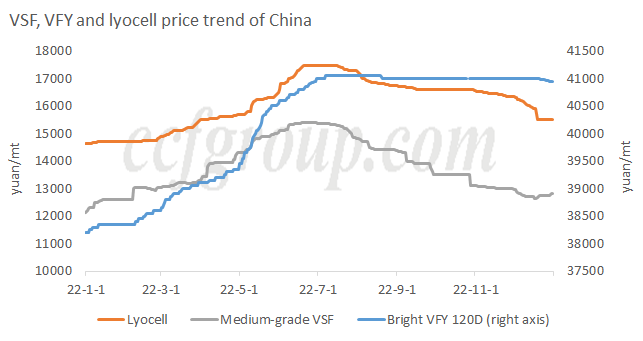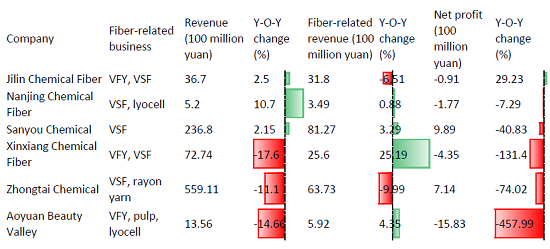2022 financial results of Chinese listed cellulose fiber companies
There were many emergencies in 2022, such as the Russia-Ukraine conflict, the repeated spread of the COVID-19, and the sharp rise in interest rates by the Federal Reserve, etc. (the greater impact was still brought by the pandemic), leading to severe fluctuations in the commodity market. From the perspective of the cellulose fiber industry, VSF, VFY and lyocell rose sharply in the first half of 2022, and were stable or weak in the second half of the year. At present, the annual reports of Chinese listed companies have been fully disclosed. Let us take a look at the details.


Jilin Chemical Fiber is mainly engaged in the production and sales of VSF, VFY and carbon fiber. During the reporting period, with the support of carbon fiber and other business, the revenue increased slightly. The fiber-related business shrank due to the sharp contraction in the production and sales of VSF (VSF converted to commissioned processing model from July 2022), but the decline in revenue was not large under the background of rising prices. Among them, the output of VFY and VSF was 60,707 tons and 42,948 tons respectively (down 6,552 tons and 63,104 tons year-on-year), and the sales volume was 70,669 tons and 47,345 tons respectively (down 54 tons and 56,452 tons year-on-year).
Nanjing Chemical Fiber mainly produces and sells VSF and lyocell. During the reporting period, the viscose fiber market was affected by the difficult situation. The lines were totally shut down twice for 135 days, affecting 19,000 tons of output, and the annual output was 28,527 tons (a year-on-year decrease of 5,049 tons). The lyocell project (phase I 40kt/yr line of the 100kt/yr plant) has fully entered the final stage, and is scheduled to start commissioning in the first half of 2023. The line is still being tested currently.
Sanyou Chemical's main products are VSF, soda ash, PVC, caustic soda and organic silicon. During the reporting period, the production and sales of VSF were 650.2kt and 663.6kt respectively (a year-on-year decrease of 31.5kt and 4.8kt), and the net profit was -570 million yuan (a year-on-year decrease of 840 million yuan).
Xinxiang Chemical Fiber mainly produces and sells VFY and spandex. During the reporting period, due to the sharp drop in spandex price, the revenue declined significantly. The revenue of VFY increased by 25.19% year-on-year (2.56 billion yuan) under the circumstance of rising volume and price, and the output and sales volume of VFY was 66,782 tons and 69,423 tons respectively (a year-on-year increase of 2,408 tons and 2,301 tons).
Zhongtai Chemical is mainly engaged in chlor-alkali chemical and viscose industry. During the reporting period, it invested 65% of the equity in Xinjiang Xingtai Fiber Technology Co., Ltd., thus adding 150kt/yr VSF capacity and 500,000 spindles of yarn capacity. During the year, the production and sales of VSF was 501.8kt and 232.1kt respectively (a year-on-year decrease of 68.1kt and 35.3kt), and the production and sales of rayon yarn was 265.4kt and 244.8kt respectively (a year-on-year decrease of 32.1ktand 55.5kt).
Aoyuan Beauty Valley is mainly engaged in bio-based fiber (lyocell and VFY) and medical beauty business. During the reporting period, the accounting firm issued a disclaimer of opinion report. During the year, the fiber-related revenue was 592 million yuan, a year-on-year increase of 4.35%. Among them, the output of VFY and lyocell was 9,546 tons and 8,409 tons respectively (with combined statistics of 18,539 tons, a year-on-year decrease of 584 tons), and sales were 9,878 tons and 10,292 tons respectively (with combined statistics of 19,928 tons, a year-on-year increase of 243 tons).
To sum up, the total revenue of cellulose fiber companies was divided in 2022, without great ups or downs. The revenue related to cellulose fiber increased mostly year-on-year, but there was no increase in profits. Although the price of cellulose fiber rose significantly, the cost of raw materials gained even bigger increment. Among them, there were mostly losses for VSF and lyocell, while VFY was relatively profitable.
- Top keywords
- Cotton Price
- Cotton Futures Price
- Cotton Futures
- CZCE
- PTA Futures Price
- Chemical Fiber
- Polyester Prices
- Wool price
- PTA Futures
- Shengze Silk
- China
- Yarn Price
- price
- China Textile City
- Fibre Price
- Benzene Price
- Cotton
- Index
- Cotton Index
- PTA
- fabric price
- NYMEX
- Top 10
- textile industry
- Spot Cotton
- Cotton Yarn
- Polyester Price
- Futures
- PTA Price
- cotton yarn price

